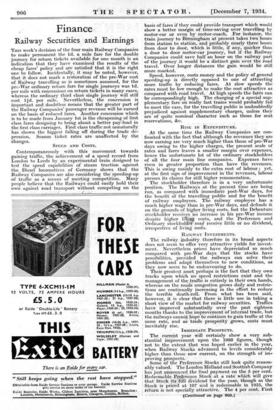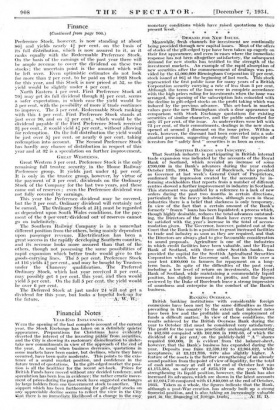Finance
Railway Securities and Earnings Tins week's decision of the four main Railway Companies to make permanent the Id. a mile fare for the. double journey for return tickets available for one month is an indication that they have examined the results of the cheap fares' policy and are satisfied that it is the right one to follow. Incidentally, it may be noted, however, that it does not mark a restoration of the pre-War cost of Railway travelling as is sometimes assumed, for the pre-War ordinary return fare for single journeys was ld. per mile with concessions on return tickets in many cases, whereas the ordinary third clasi single journey will still cost I d. per mile. Nevertheless, the concession is important and doubtless means that the greater part of the Railway Companies' passenger revenue will be earned on the basis of reduced fares. Another concession which is to be made from January 1st is the cheapening of first class fares designing to bring about a better payload in the,first class carriages. First class traffic not unnaturally has shown the biggest falling off during the trade de- pression. Season ticket rates are unaffected by the changes.
SPEED AND COSTS.
Contemporaneously with this movement towards gaining traffic, the achievement of a speed record from London to Leeds by an experimental train designed to test *the speed capabilities of steam traction against the. Diesel locomotives of Germany shows that the Railway Companies are also considering the speeding-up of traffic as a means of meeting competition. Many people believe that the RailWays could easily hold their own • against road transport without competing on the basis of fares if they could provide transport which would show a better margin of time-saving over travelling by motor-car or even by motor-coach. For instance, the train journey to Birmingham at present takes two hours from station to station, and probably nearly three hours from door to door, which is little, if any, quicker than a door to door motor-car journey, but if the Railway Companies could save half an hour on the railway part of the journey it would be a distinct gain _over -the road travel. Over longer distances the gain would- be still more marked. _ Speed, however, costs money and the policy of general speeding-up is directly opposed to one of attracting more traffic by reducing fares. At slow speeds the rates must be low enough to make the cost attractive as compared with road travel. - At' high SpeedS the &kis can be correspondinglx high. The charging of a special sup- plementary fare on really fast trains would probably fail to meet the case, for the travelling public is undoubtedly prejudiced against supplementary charges, unless they are of quite nominal character such as those for seat reservations, &c.
RISE IN EXPENDITURE.
At the same time the Railway Companies are con- fronted with the fact that although the revenues they are now earning are very much higher than those of pre-War days owing to the higher charges, the present scale of rates and fares leaves a smaller margin over expenses, hence the unfortunate lot of the ordinary stockholders of all the four main line companies. Expenses have risen in greater proportion than have the revenues. This is owing mainly to the extra cost of labour ; yet, at the first sign of improvement in the revenues, labour presses its claims for still higher remuneration. The stockholder therefore is in a very unfortunate position. The Railways at the present time are being run, as compared with immediate post-War days, for the benefit of the travelling public and for the benefit of railway employees. The railway employee has a much higher wage than in pre-War days, and defends it on the grounds_of higher living costs, but the Debenture stockholder receives no increase in his pre-War income despite higherli costs, and the Preference and Ordinary stockholereTmaii receive little or no dividend, irrespective of living costs.
RAILWAY INVESTMENTS.
The railway ikdustiyaaa therefore in its broad aspects does not seem to offer very attractive yields for invest- ment. Nevertheless prices have depreciated so much compared with pre-War days that the stocks have possibilities, provided the railways can solve their problems and adapt themselves to new conditions, as they now seem to be endeavouring to do.
Their greatest asset perhaps is the fact that they own tracks upon which no speed restrictions exist and the management of the, traffic is entirely in their own hands, whereas on the roads congestion grows daily and restric- tions are continually increasing in the effort to reduce the terrible 'death-roll. From what has been said, however, it is clear that there is little use in taking a short view of the market for railway securities. Traffics have improved substantially over the past eighteen months thanks to the, improvement of internal trade, but the railways cannot hope to continue to gain traffic at the same rate, and as trade prosperity grows, costs must inevitably rise.
IMMEDIATE PROSPECTS.
The current year will certainly show a very sub- stantial improvement upon the 1938 figures, though not to the extent that was hoped earlier in the year, when Railway Stocks advanced to levels considerably higher• than those now current, on the strength of proving prospects. Some of the Preference Stocks still look quite reason- ably valued. The London Midland and Scottish Company has just announced the final payment on the 5 per cent. Redeemable Preference Stock at a rate' which will give that Stock its, frill dividend for the year, though as the Stock is priced at 107 and is redeemable in 1955, the return is not specially attractive. The 4 per cent. First (Continued on page 908.)
Finance
(Continued from page 906.) Preference Stock, however, is now standing at about 864 and yields nearly 44 per - cent. on the basis of its full distribution, which is now assured to -it, as it ranks equally with the Redeemable, Preference Stock. On the basis of the earnings of the past year there 'will be ample revenue to cover the dividend oft these two stocks ; the uncertain point is 'the amount which will be left over. Even optimistic estimates do not look far more than 2 per cent. to be paid on the 1923 Stock for this year, and this Stock is now priced at 52, so the yield would be slightly under 4 per cent. North Eastern 4 per cent. First Preference Stock at 704 may get its full dividend though 84 per cent. seems a safer expectation, in which case the yield would be 5 per cent. with the possibility of more if trade continues to improve. The 5 per cent. Redeemable Stock ranking with this 4 per cent. First Preference Stock stands at just over 90, and on 4/ per cent. which would be the dividend payable ,if 'the First Preference -Stock received 34 per cent., it would yield 41 per cent., Without-allowing for redemption. On the full distribution the yield would be just over 54 per cent. or nearly 6 per cent. taking redimption into account. The Second Preference Stock' has hardly any chance of distribution in respect of this year and at 32 is a speculation on further improvement.
GREAT WESTERNS.
Great Western 5 per cent. Preference Stock is 'the only remaining full trustee,._security_hi the Home Railway Preference group. It yields. , just under 44. per cent. It is only in. the trustee group, however, by virtue of the payment "of 3 per cent. dividends on the Ordinary Stock of the Company for the last two years, and these came out of reserves ; even the -Preference dividend was not fully covered. by earnings. • • • This year the Preference . dividend may be covered, but the 8 per cent. Ordinary dividend will certainly not be earned. . The Ordinary. Stock at .514 must be regarded as dependent upon South Wales conditions, for the pay- ment- of- the 3 ;per seentTklividend out 'Cif-reserves cannot go on indefinitely. The Southern Railway- Company, is in a 'somewhat different position from.the others; being mainly dependent upon passenger revenue. Electrification has been a great'success in the rapidly developing SOuthern‘connties,' and its : revenue looks' more assured than that of the others, though not possessing the same possibilities of rapid expansion which 'better trade would give to the goods-carrying lines. The 5 per cent. Preference Stock at. 116 yields 41 per cent., and nIay be bought by Trustees under the Chancery qualification. The Preferred Ordinary Stock, which last year _receivd 8 per cent., may possibly get 4 per cent. this year; and then would yield 5 per cent. On the full 5 per cent. the yield would be over 6 per cent.
The Deferred Stock at just under 24 will not get a dividend for this year, but looks a hopeful hick-up for



















































 Previous page
Previous page